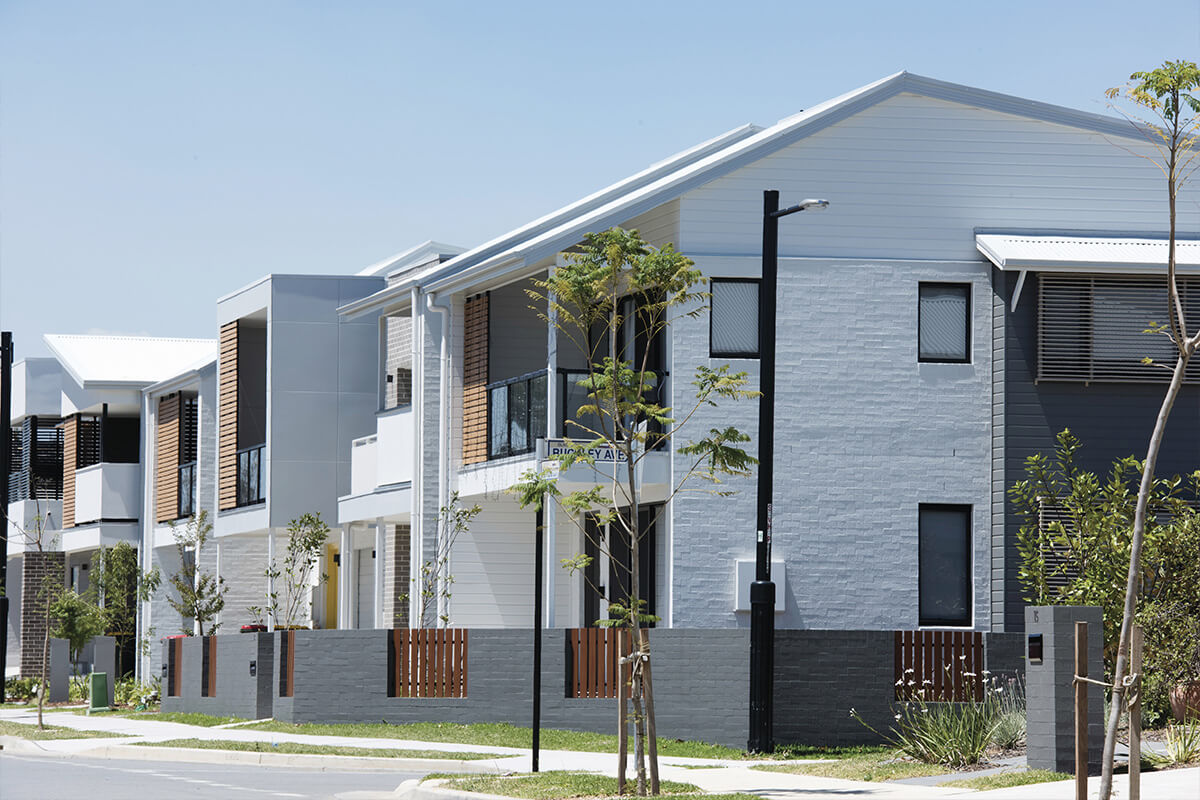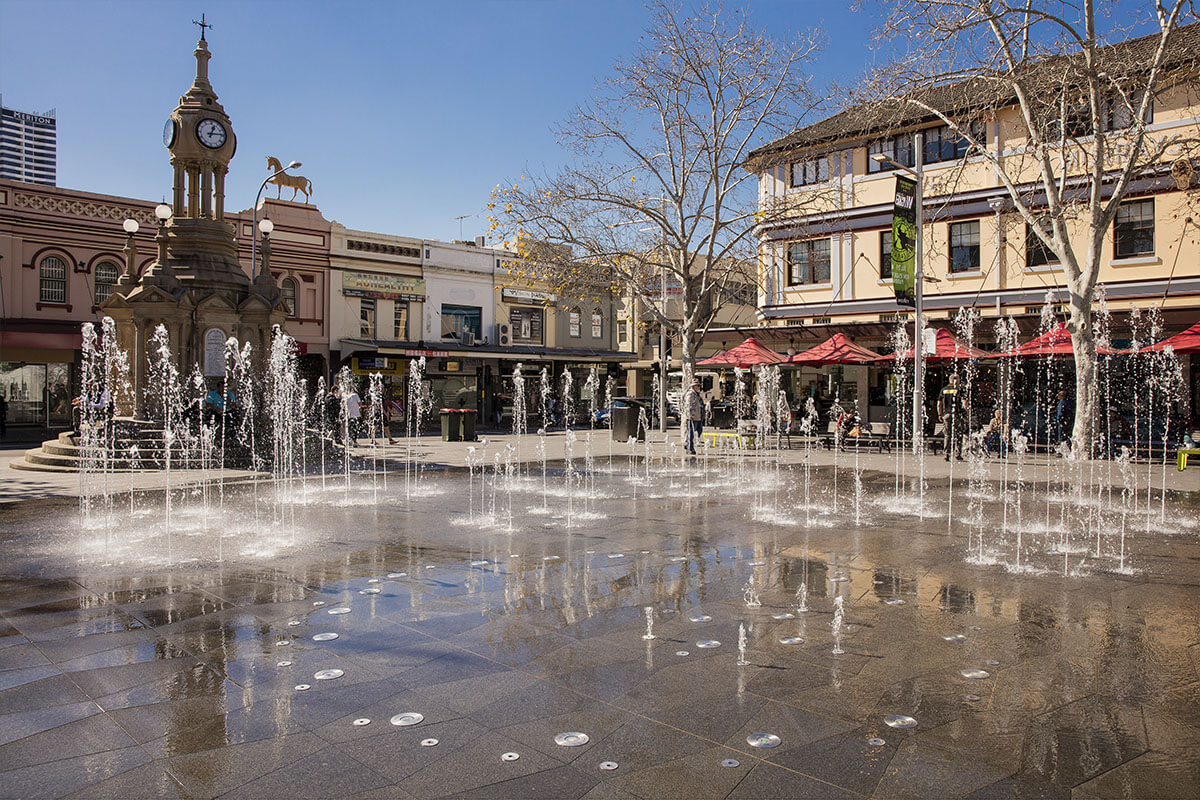Building materials readily absorb and store heat. They can raise local day-time temperatures, and also temperatures over night as they gradually release heat back into the local environment.
We can all play a role in building cooler developments.
Select cool roofs, walls and pavements
When designing a precinct or site:
Choose cool roof materials
- Lighter coloured roof materials to lower heat absorbency.
- Solar panels redirect a portion of the sun’s energy and can provide shade to a roof.
- ‘Green’ roofs have a higher reflectivity than typical roofing materials and shade the surface.
- Biosolar roofs that combine solar panels and green cover to increase cooling benefits.
For more information, visit Take action with greening.
Design cool walls
- Orient buildings to optimise solar access and reduce the exposure of long, thermally massive walls to heat.
- Shade west-facing walls that receive the hot afternoon sun, using structures such as pergolas, shade sails, awnings and green cover.
- Consider ‘green’ walls or vertical gardens, especially if you have limited ground space to reduce heat absorption and provide natural insulation.
- Apply solar-reflective paint or coatings to exterior walls, especially on the north and west sides of the home. Use these with care and in combination with shading elements to minimise glare and any heat redirected to outdoor areas.
For more information, visit Take action with urban structure.
Install cool windows
- Place your windows to let winter sun in and keep summer sun out.
- Consider how much glazing you need – a smaller window-to-floor-space ratio makes for a more stable indoor climate.
- Provide shade to north-facing windows.
- Where possible, use high-performance glass: double or triple glazing.
Minimise paved surfaces and increase cool paving
- Prioritise soft landscaping, and create hard-stand areas only where necessary.
- Where possible, choose real grasses over artificial turf and avoid synthetic soft-fall materials.
- Consider pavement materials with high reflectivity, such as paving with lighter pigments and aggregates in asphalt and concrete.
- Add reflective coatings to existing pavements – consider the local environment to minimise glare.
- Choose permeable paving such as permeable asphalt, gravel, composite resin, porous bricks and clay, where traffic loads are light and where there is an opportunity for rainfall to soak into soil below.
Retrofit cool materials and enhance cool spaces
Cool your home or business with the cost-effective retrofits and strategies below.
- Apply reflective coating to your roof or install solar panels.
- Shade north-facing windows and walls with awnings, louvres, shade cloths, or by planting deciduous trees or vegetation – visit Take action with greening for more information.
- Improve the performance of your windows, glass doors, and skylights by installing:
- high-performance glass such as double or triple glazing, or
- easy, reversible window treatments such as:
- curtains and blinds with insulating materials (that is, thermal lining)
- window tints or reflective coverings
- temporary double glazing or secondary glazing.
- Reduce hard-paved areas and replace them with permeable paving or soft landscaping.
- Add shade devices to outdoor paved areas including shade sails, trees and green cover – visit Take action with greening for more information.
- Install roof, ceiling, wall and floor insulation that meets or exceeds National Construction Code requirements for your climate region.
- Replace carpet on concrete with linoleum or marmoleum to increase thermal mass and maintain a stable indoor climate year-round.
Maintain cool materials
Maximise cooling benefits around your home and business through regular maintenance practices.
Maintaining cool roofs
- Inspect your cool roof regularly to check for any signs of damage. Schedule maintenance tasks, such as resealing seams, repairing damaged sections, or reapplying protective coatings, as recommended by the manufacturer or a qualified roofing professional.
- Clean your cool roof to maintain its solar reflectance. Always refer to the manufacturer’s guidelines for the proper cleaning procedure to avoid damage.
Insulation maintenance
- Inspect insulation regularly for signs of damage or wear. Look for gaps, holes, or compression, which can significantly reduce its effectiveness.
- Consider replacing insulation if your home experiences:
- fluctuating indoor temperatures
- higher than usual energy bills, which may indicate heat loss or gain through the building envelope
- pest infestation, as ceilings and other insulated spaces are common areas for pests to nest, compromising the insulation.
- Ensure that your heating, ventilation, and air conditioning (HVAC) ducts are properly sealed and insulated.
Tree maintenance
To ensure trees reach their greatest cooling potential, give regular care and support. This includes watering, pruning, and mulching as needed. For more information, visit Take action with greening.
Permeable pavement maintenance
To maintain the effectiveness of permeable paving, allowing rainwater to pass through, promote groundwater recharge and reduce surface runoff.
- Regularly clear away leaves, dirt, and other debris.
- Use a high-pressure hose annually to clean the surface.
- Regularly inspect the pavement for weed growth and remove weeds promptly.
- If your permeable paving has gravel or sand in the joints, periodically check and refill these areas to maintain structural integrity and permeability.
Deliver cool materials through planning mechanisms
Strategic plans and planning controls can be used by councils and state government to respond to urban heat. For more information, visit Using planning strategies and controls for cooling.
Other actions you can take
We can all play a role in building cooler developments.
We can all protect existing trees and enhance urban greening.
We can all look for ways to sustainably incorporate water.
Resources
The Guide to Urban Cooling Strategies produced by the Low Carbon Living CRC, provides practical guidance for councils, government and industry seeking to optimise development projects to modern urban microclimates and mitigate urban heat island effects. It provides strategies to integrate cool surfaces and paving in projects.
Urban Green Cover Technical Guidelines provides practical guidance for councils, government and industry on how to integrate green and cool roofs into urban development to mitigate urban heat.
Urban Heat Planning Toolkit developed by Western Sydney Regional Organisation of Councils to help local government strengthen their planning provisions to reduce the impacts of heat.
Cool Suburbs Tool is a rating and assessment tool for building heat resilience in urban planning and development. It provides detailed guidance on reflectivity and optimal shading to reduce heat in and around homes and other buildings.
Australia's Guide to Environmentally Sustainable Homes provides guidance for households on the use of passive building design for cooling your home.
Cooling your home aims to help residents stay safer and more comfortable during climate extremes. It offers practical advice on home retrofits, appliances choices and cost-effective strategies.
The NSW Government provides advice for insulation and draught proofing to help households keep their home warm in winter and cool in summer. It includes tips on selecting the right insulation materials, sealing gaps to prevent draughts, and other measures to improve energy efficiency and indoor comfort.


